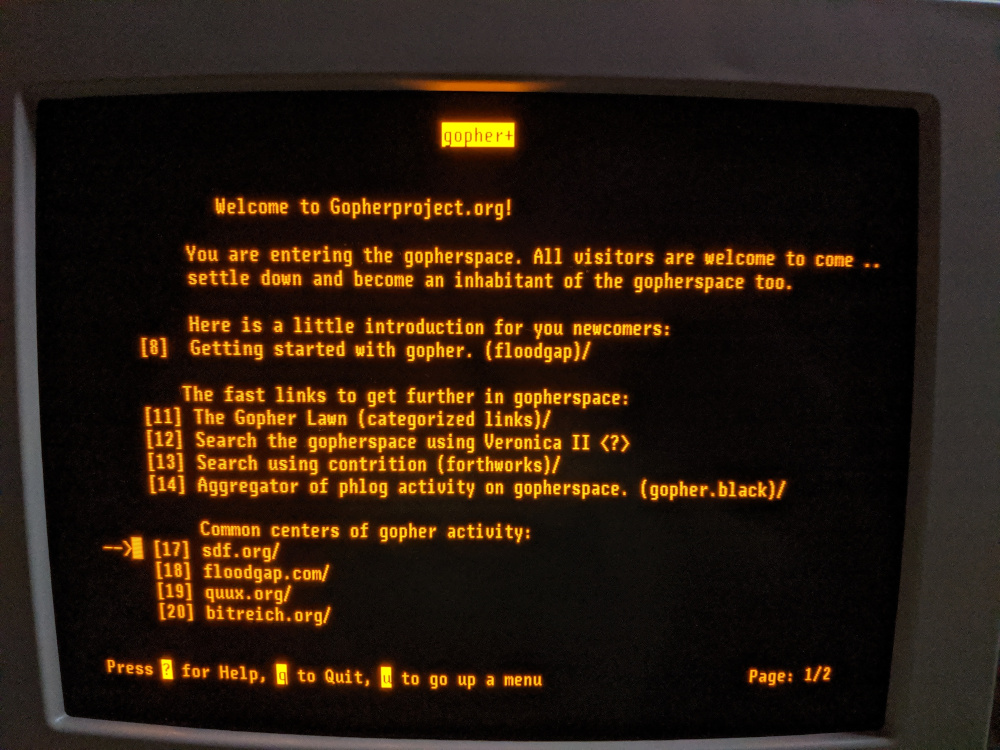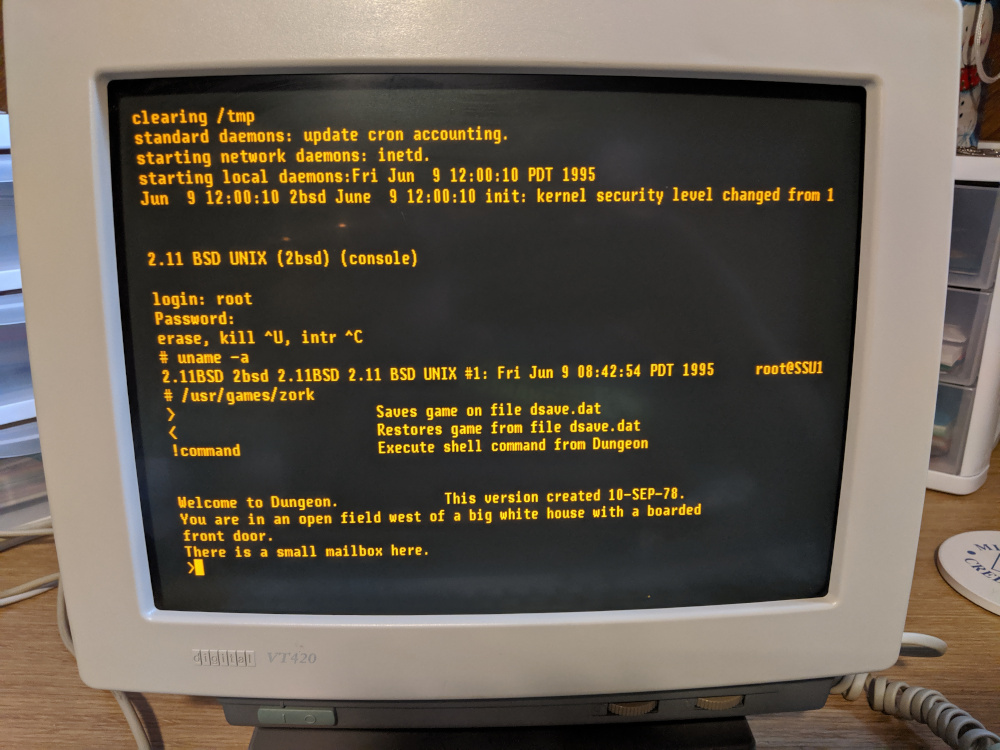It seems I’ve been on a bit of a vintage computing kick lately. After connecting an original DEC vt420 to Linux and resurrecting some old operating systems, I dove into UUCP.
In fact, it so happened that earlier in the week, my used copy of Managing UUCP & Usenet (its author list includes none other than Tim O’Reilly) arrived. I was reading about the challenges of networking in the 70s: half-duplex lines, slow transmission rates, and modems that had separate dialers. And then I stumbled upon long-distance radio. It turns out that a lot of modern long-distance radio has much in common with the challenges of communication in the 1970s – 1990s, and some of our old protocols might be particularly well-suited for it. Let me explain — I’ll start with the old software, and then talk about the really cool stuff going on in hardware (some radios that can send a signal for 10-20km or more with very little power!), and finally discuss how to bring it all together.
UUCP
UUCP, for those of you that may literally have been born after it faded in popularity, is a batch system for exchanging files and doing remote execution. For users, the uucp command copies files to or from a remote system, and uux executes commands on a remote system. In practical terms, the most popular use of this was to use uux to execute rmail on the remote system, which would receive an email message on stdin and inject it into the system’s mail queue. All UUCP commands are queued up and transmitted when a “call” occurs — over a modem, TCP, ssh pipe, whatever.
UUCP had to deal with all sorts of line conditions: very slow lines (300bps), half-duplex lines, noisy and error-prone communication, poor or nonexistent flow control, even 7-bit communication. It supports a number of different transport protocols that can accommodate these varying conditions. It turns out that these mesh fairly perfectly with some properties of modern long-distance radio.
AX.25
The AX.25 stack is a frame-based protocol used by amateur radio folks. Its air speed is 300bps, 1200bps, or (rarely) 9600bps. The Linux kernel has support for the AX.25 protocol and it is quite possible to run TCP/IP atop it. I have personally used AX.25 to telnet to a Linux box 15 miles away over a 1200bps air speed, and have also connected all the way from Kansas to Texas and Indiana using 300bps AX.25 using atmospheric skip. AX.25 has “connected” packets (as TCP) and unconnected/broadcast ones (similar to UDP) and is a error-detected protocol with retransmit. The radios generally used with AX.25 are always half-duplex and some of them have iffy carrier detection (which means collision is frequent). Although the whole AX.25 stack has grown rare in recent years, a subset of it is still in wide use as the basis for APRS.
A lot of this is achieved using equipment that’s not particularly portable: antennas on poles, radios that transmit with anywhere from 1W to 100W of power (even 1W is far more than small portable devices normally use), etc. Also, under the regulations of the amateur radio service, transmitters must be managed by a licensed operator and cannot be encrypted.
Nevertheless, AX.25 is just a protocol and it could, of course, run on other kinds of carriers than traditional amateur radios.
Long-range low-power radios
There is a lot being done with radios these days, much of which I’m not going to discuss. I’m not covering very short-range links such as Bluetooth, ZigBee, etc. Nor am I covering longer-range links that require large and highly-directional antennas (such as some are doing in the 2.4GHz and 5GHz bands). What I’m covering is long-range links that can be used by portable devices.
There is always a compromise in radios, and if we are going to achieve long-range links with poor antennas and low power, the compromise is going to be in bitrate. These technologies may scale down to as low at 300bps or up to around 115200bps. They can, as a side bonus, often be quite cheap.
HC-12 radios
HC-12 is a radio board, commonly used with Arduino, that sports 500bps to 115200bps communication. According to the vendor, in 500bps mode, the range is 1800m or 0.9mi, while at 115200bps, the range is 100m or 328ft. They’re very cheap, at around $5 each.
There are a few downsides to HC-12. One is that the lowest air bitrate is 500bps, but the lowest UART bitrate is 1200bps, and they have no flow control. So, if you are running in long-range mode, “only small packets can be sent: max 60 bytes with the interval of 2 seconds.” This would pose a challenge in many scenarios: though not much for UUCP, which can be perfectly well configured to have a 60-byte packet size and a window size of 1, which would wait for a remote ACK before proceeding.
Also, they operate over 433.4-473.0 MHz which appears to fall outside the license-free bands. It seems that many people using HC-12 are doing so illegally. With care, it would be possible to operate it under amateur radio rules, since this range is mostly within the 70cm allocation, but then it must follow amateur radio restrictions.
LoRa radios
LoRa is a set of standards for long range radios, which are advertised as having a range of 15km (9mi) or more in rural areas, and several km in cities.
LoRa can be done in several ways: the main LoRa protocol, and LoRaWAN. LoRaWAN expects to use an Internet gateway, which will tell each node what frequency to use, how much power to use, etc. LoRa is such that a commercial operator could set up roughly one LoRaWAN gateway per city due to the large coverage area, and some areas have good LoRa coverage due to just such operators. The difference between the two is roughly analogous to the difference between connecting two machines with an Ethernet crossover cable, and a connection over the Internet; LoRaWAN includes more protocol layers atop the basic LoRa. I have yet to learn much about LoRaWAN; I’ll follow up later on that point.
The speed of LoRa ranges from (and different people will say different things here) about 500bps to about 20000bps. LoRa is a packetized protocol, and the maximum packet size depends
LoRa sensors often advertise battery life in the months or years, and can be quite small. The protocol makes an excellent choice for sensors in remote or widely dispersed areas. LoRa transceiver boards for Arduino can be found for under $15 from places like Mouser.
I wound up purchasing two LoStik USB LoRa radios from Amazon. With some experimentation, with even very bad RF conditions (tiny antennas, one of them in the house, the other in a car), I was able to successfully decode LoRa packets from 2 miles away! And these aren’t even the most powerful transmitters available.
Talking UUCP over LoRa
In order to make this all work, I needed to write interface software; the LoRa radios don’t just transmit things straight out. So I wrote lorapipe. I have successfully transmitted files across this UUCP link!
Developing lorapipe was somewhat more challenging than I expected. For one, the LoRa modem raw protocol isn’t well-suited to rapid fire packet transmission; after receiving each packet, the modem exits receive mode and must be told to receive again. Collisions with protocols that ACKd data and had a receive window — which are many — were a problem so bad that it rendered some of the protocols unusable. I wound up adding a “expect more data after this packet” byte to every transmission, and have the receiver not transmit until it believes the sender is finished. This dramatically improved things. There’s more detail on this in my lorapipe documentation.
So far, I have successfully communicated over LoRa using UUCP, kermit, and YMODEM. KISS support will be coming next.
I am also hoping to discover the range I can get from this thing if I use more proper antennas (outdoor) and transmitters capable of transmitting with more power.
All in all, a fun project so far.


